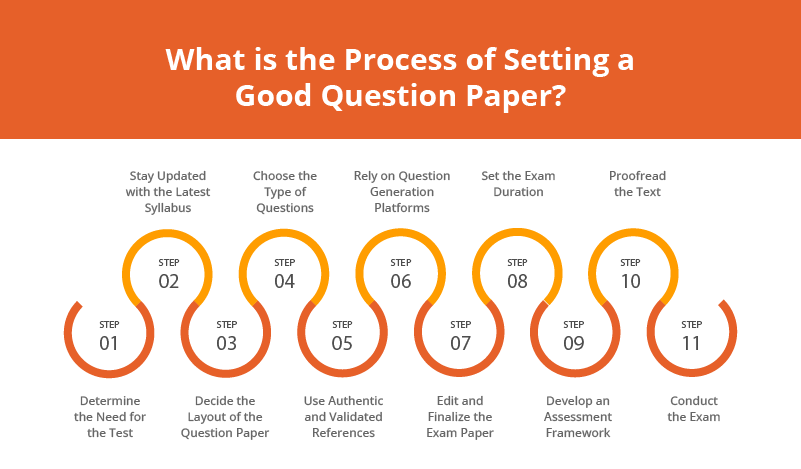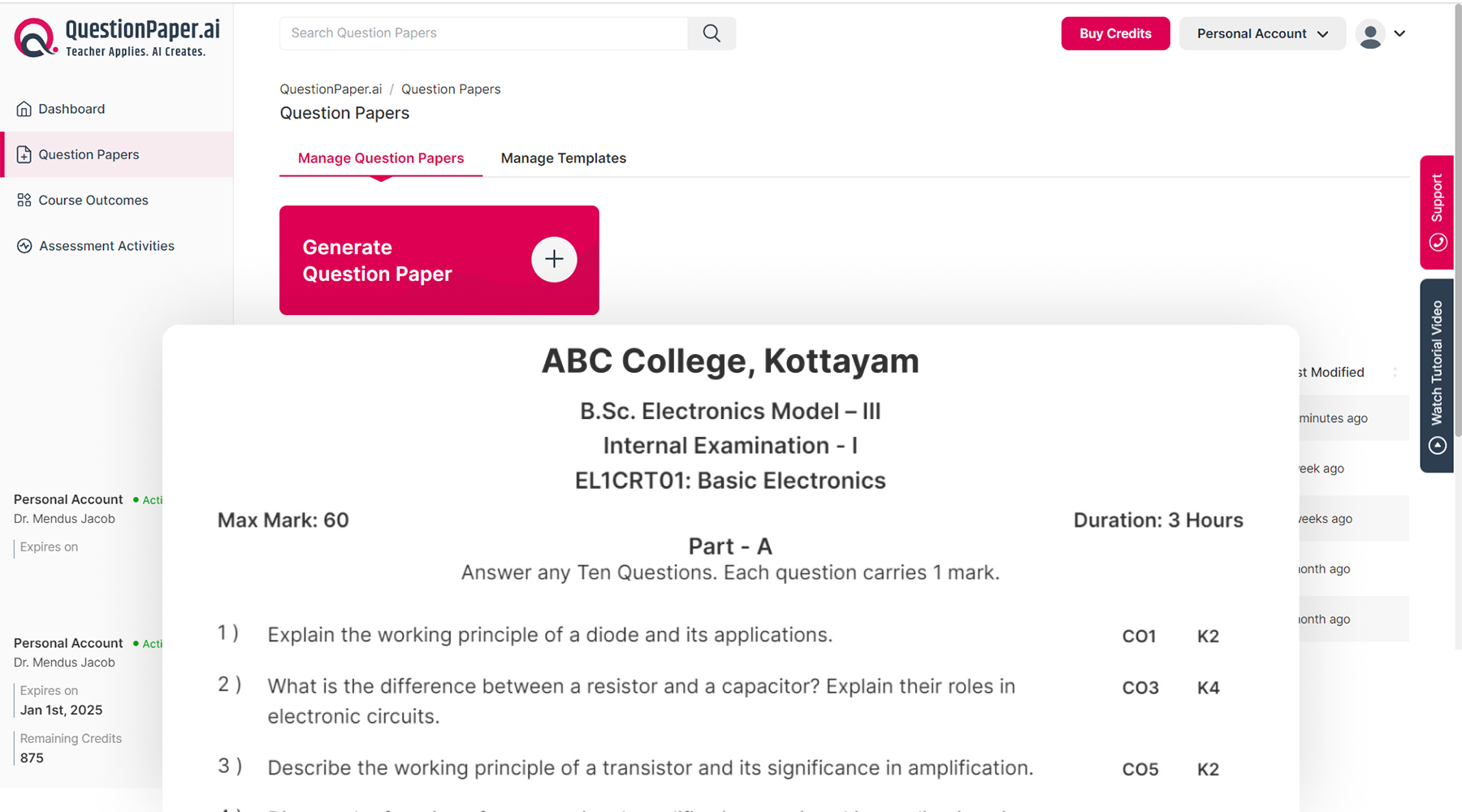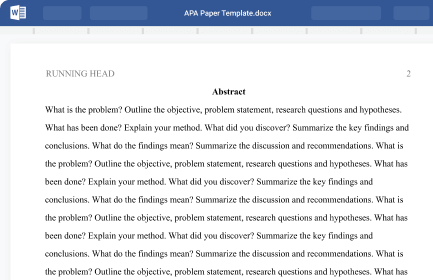- A Teacher’s Guide to Setting an Exam Question Paper »

A Teacher’s Guide to Setting an Exam Question Paper

Crafting a good question paper is like putting together a puzzle – you need the right pieces for it to work. It’s not just about testing if students remember specific facts; it’s about learning how well they connect the dots and think critically.
In this guide, we’ll explore valuable insights on how to set a question paper that not only assesses knowledge but also encourages critical thinking, making the process enjoyable for students.
Quick Links
What is the Process of Setting a Good Question Paper?

An exam paper should be set with the intent to enhance students’ learning outcomes by testing their knowledge effectively. A common mistake that some teachers make is that they set high-stakes question papers that greatly challenge students’ comprehension of topics. This could demotivate students and create undue academic pressure. What teachers should aim to do instead is design a versatile question paper that has a balance of both simple and complex topics.
Let’s go through the process that can help you set a good question paper:
Determine the Need for the Test
Stay updated with the latest syllabus, decide the layout of the question paper, choose the type of questions, use authentic and validated references, rely on question generation platforms, edit and finalize the exam paper, set the exam duration, develop an assessment framework.
An effective assessment framework is based on the objective of the test and details the learning outcomes, specific competencies, content domains and skills that need to be assessed.
Step 1: Design A Blueprint
Based on the assessment framework, teachers should create a blueprint that details all the content domains to be tested, question formats and types – Multiple-Choice Questions (MCQs), short answers, etc., the total length of the test and an aggregate percentage of different content areas within the test.
Step 2: Choose An Effective Test Format and Scoring Guides
Broadly, the types of exam questions are either selected-response questions such as true or false, MCQs, etc., or constructed-response questions like long-essay type questions. The scoring guide must be aligned with the cognitive level of the questions.
Step 3: Conduct Tool Validation
Proofread the text, conduct the exam, types of questions in an exam paper, objective questions, multiple choice.
MCQs are among the most popular types of questions that have been used for many years across varied levels of examinations. They are composed of one question or a statement, also known as a stem, that has multiple possible answers, called choices. The stem can sometimes be a partial statement and will often have 3 to 5 choices, out of which one is correct, and the rest are alternatives or distractions.
Ideal for: These types of exam questions are best suited for clarifying key concepts and assessing students’ abilities to apply their understanding of topics effectively.
Bonus tip: Avoid using statements directly from the textbook. Instead, frame it in your own words to make the stem versatile. For choices, use at least 3 options that are based on common student misconceptions. This will help clarify concepts better.When dealing with multiple-choice questions, try to keep these things in mind:
- Clear Question: Make sure the question is straightforward.
- Positive Wording: State things positively when you can, but if you have to go negative, make it clear.
- Clear Correct Answer: The right answer should be obvious.
- Good Grammar: Keep the language consistent and easy to understand.
- Tricky Choices: The wrong answers should sound reasonable to someone who doesn’t know the material.
- No Clues: Don’t give away the answer in the way you phrase the choices.
- Mix It Up: Make sure the length of the answers doesn’t give away the right one.
- Smart Use of “All of the Above” or “None of the Above”: Only use these when they really fit.
True or False
True or false questions are those where a statement is presented, which in this case acts as the stem, and students are required to indicate whether it is true or false. A huge advantage for teachers here is that such questions are the easiest to review and score. Such questions can tend to be either too easy or too difficult in nature. However, this helps create a versatile question paper that effectively tests students of varying aptitudes.
Ideal for: They are great for testing a large amount of content and evaluating a student’s understanding of topics with two logical responses.
Bonus tip: Use simple and clear statements that reflect a single idea. This will keep confusion at bay and allow students to interpret the statement correctly. You may also ask students to correct false statements to enhance the effectiveness of these types of exam questions.
Keeping these true and false questions fair involves:
- Simple Statements: Keep the statements short and clear.
- Clear True or False: Make sure there’s no room for doubt on whether something is true or false.
- Avoid Double Negatives: Don’t make things more complicated with double negatives.
- No Clues: Like with multiple-choice, keep things clue-free.
- Balanced Mix: Have about the same number of true and false statements.
Sentence completion questions test students’ ability to apply knowledge. Educators can ensure effective construction by:
- Contextual Blanks: Pose questions containing blanks within a statement or paragraph, requiring students to fill them correctly.
- Understanding Over Recognition: Emphasise the need for students to find answers, moving beyond simple recognition.
- Knowledge Assessment: Suitable for testing knowledge levels, these questions go beyond mere recognition.
These are the most effective types of exam questions to test the relationship between objects. It is specifically useful in subjects that involve events, dates, names, and important places. It generally has two columns – one column is the stem, and the other has corresponding responses. Students need to go through the first column and find the correct response from the options in the second column.
Ideal for: They are an excellent option for data-rich content areas and help test students’ knowledge and comprehension levels.
Bonus tip: Include directions that clearly mention the basis for matching the stimuli with responses. Also, limit the number of matching items and keep it between 5 and 15 items to avoid confusion.
To make good matching questions, keep these points in mind:
- The things you’re matching should have something in common.
- Say how the matching works – can things be used more than once?
- Put all the matching stuff on the same page.
- Make the matches uneven by adjusting the lists.
Classification Questions
Subjective questions, short answers.
Short answers generally require students to answer any given prompts in brief, limiting the length to a few words or sentences. The length of the answer can be based on the weightage of marks it carries. Such questions are easy to construct, faster to score, and allow teachers to cover a broader range of course content.
Ideal for: These questions are great for testing foundational knowledge of key concepts, facts, and terms.
Essay or Descriptive
Essay-type questions are those that demand long-form, logical, and integrated answers, which can vary in length, ranging from a few paragraphs to a few pages. Teachers may choose to include several sub-questions based on the curriculum and nature of assessment. There can be two forms of responses – extended response and restricted response. The former is where students explain their understanding and demonstrate creativity with examples. Teachers can use this to test their ability to evaluate and synthesise problems. Restricted responses involve parameters of comparison and distinction. It demands students to build on their knowledge and understanding of topics. An example of this would be, ‘Plastic has become a considerable hazard in today’s environment. List out the ways in which it can harm us and how we should address its impact.
Ideal for: It is a great question type to measure cognitive processes, gain student opinions on key concepts, and test their ability to organise and apply their understanding of topics.
Definition Type Questions
Definition-type questions play an important role in assessing a student’s grasp of fundamental concepts. These questions aim to evaluate a student’s ability to provide a concise and accurate explanation of a specific term, concept, or idea. When crafting such questions, educators should use phrases like “Define,” “What is the meaning of,” or “Explain the term.” The aim is to get students to explain what they know in a simple and clear way.
Ideal for: Definition-type questions come in handy when you want to check if students really grasp the main concepts in different subjects. They’re an excellent tool for educators to measure how well students understand the basics of a particular topic.
Opinion-Based Questions
Opinion-based questions invite students to express their views on a given topic, often requiring them to agree or disagree with a provided opinion. These questions are well-suited for courses or subjects that involve critical thinking, analysis, and debate. They are particularly valuable in fields where multiple viewpoints are valid, such as the social sciences, humanities, and philosophy.
Ideal for: Opinion-based questions are best used in courses that encourage critical thinking and analysis. They prompt students to explore and defend their opinions, contributing to a more nuanced understanding of complex issues.
Scenario-Based Questions
Scenario-based questions present students with hypothetical situations or scenarios, challenging them to apply their knowledge, skills, and critical thinking to solve a problem or make a decision within a given context. These questions are designed to evaluate a student’s ability to analyse, synthesise, and apply what they’ve learned in a real-world or practical setting.
Ideal for: Scenario-based questions are effective in assessing a student’s application of knowledge to practical situations. They are well-suited for subjects where the ability to make informed decisions or solve problems is crucial.
Getting Around the Difficulty Level of Question Paper
Syllabus planning, selection of questions, time consideration for students, 5 simple tips to keep things fair and error-free, third-party review committee, two-level checking and effective moderation, creating a pool of questions, using open educational sources, considering exam scope and societal trends, how extramarks simplifies test paper creation for teachers.
Extramarks’ Assessment Center is your reliable companion, making assessments a breeze! It’s super easy to use, with a friendly interface that lets you customise tests according to what you’ve taught. You can pick questions quickly from a question bank and tweak them to match different topics and student levels. The best part? You and your fellow teachers can team up in real-time, share feedback, and make assessments together.
No more grading headaches either – the tool even helps with that. And there are informative data features available, providing valuable insights into your students’ performance.
Extramarks makes setting the right question paper a breeze.
Last Updated on March 13, 2024

More Recent Blogs

Importance of exam and How They can be...
Exams – the word itself might trigger strong emotions in many of us. Some might […]

What is Micro Teaching & Why It Is...
Teaching is a tough job. Teachers need special skills to teach kids and keep them […]

How Strong Teacher-Student Bonds Can Help Both Students...
Imagine a classroom where students eagerly anticipate each lesson, not just for the subject matter […]
Leave a Reply Cancel reply
Save my name, email, and website in this browser for the next time I comment.

Found the blog insightful?
Get such ed tech insights delivered weekly to your inbox, for free. Subscribe to our newsletter.
- Teaching App
- Live Classes
- Learning App
- School Solutions
- STAR Program
- NCERT Solutions for Class 12
- NCERT Solutions for Class 11
- Solved Board Paper CBSE
- Solved Board Paper ICSE
- CBSE Class 12
- CBSE Class 11
- CBSE Class 10
- ICSE Class 12
- Sample Paper CBSE
- Exam Weightage CBSE
- CBSE Class 12 Solution
- Terms of Use

Editing and Proofreading
What this handout is about.
This handout provides some tips and strategies for revising your writing. To give you a chance to practice proofreading, we have left seven errors (three spelling errors, two punctuation errors, and two grammatical errors) in the text of this handout. See if you can spot them!
Is editing the same thing as proofreading?
Not exactly. Although many people use the terms interchangeably, editing and proofreading are two different stages of the revision process. Both demand close and careful reading, but they focus on different aspects of the writing and employ different techniques.
Some tips that apply to both editing and proofreading
- Get some distance from the text! It’s hard to edit or proofread a paper that you’ve just finished writing—it’s still to familiar, and you tend to skip over a lot of errors. Put the paper aside for a few hours, days, or weeks. Go for a run. Take a trip to the beach. Clear your head of what you’ve written so you can take a fresh look at the paper and see what is really on the page. Better yet, give the paper to a friend—you can’t get much more distance than that. Someone who is reading the paper for the first time, comes to it with completely fresh eyes.
- Decide which medium lets you proofread most carefully. Some people like to work right at the computer, while others like to sit back with a printed copy that they can mark up as they read.
- Try changing the look of your document. Altering the size, spacing, color, or style of the text may trick your brain into thinking it’s seeing an unfamiliar document, and that can help you get a different perspective on what you’ve written.
- Find a quiet place to work. Don’t try to do your proofreading in front of the TV or while you’re chugging away on the treadmill. Find a place where you can concentrate and avoid distractions.
- If possible, do your editing and proofreading in several short blocks of time. Your concentration may start to wane if you try to proofread the entire text at one time.
- If you’re short on time, you may wish to prioritize. Make sure that you complete the most important editing and proofreading tasks.
Editing is what you begin doing as soon as you finish your first draft. You reread your draft to see, for example, whether the paper is well-organized, the transitions between paragraphs are smooth, and your evidence really backs up your argument. You can edit on several levels:
Have you done everything the assignment requires? Are the claims you make accurate? If it is required to do so, does your paper make an argument? Is the argument complete? Are all of your claims consistent? Have you supported each point with adequate evidence? Is all of the information in your paper relevant to the assignment and/or your overall writing goal? (For additional tips, see our handouts on understanding assignments and developing an argument .)
Overall structure
Does your paper have an appropriate introduction and conclusion? Is your thesis clearly stated in your introduction? Is it clear how each paragraph in the body of your paper is related to your thesis? Are the paragraphs arranged in a logical sequence? Have you made clear transitions between paragraphs? One way to check the structure of your paper is to make a reverse outline of the paper after you have written the first draft. (See our handouts on introductions , conclusions , thesis statements , and transitions .)
Structure within paragraphs
Does each paragraph have a clear topic sentence? Does each paragraph stick to one main idea? Are there any extraneous or missing sentences in any of your paragraphs? (See our handout on paragraph development .)
Have you defined any important terms that might be unclear to your reader? Is the meaning of each sentence clear? (One way to answer this question is to read your paper one sentence at a time, starting at the end and working backwards so that you will not unconsciously fill in content from previous sentences.) Is it clear what each pronoun (he, she, it, they, which, who, this, etc.) refers to? Have you chosen the proper words to express your ideas? Avoid using words you find in the thesaurus that aren’t part of your normal vocabulary; you may misuse them.
Have you used an appropriate tone (formal, informal, persuasive, etc.)? Is your use of gendered language (masculine and feminine pronouns like “he” or “she,” words like “fireman” that contain “man,” and words that some people incorrectly assume apply to only one gender—for example, some people assume “nurse” must refer to a woman) appropriate? Have you varied the length and structure of your sentences? Do you tends to use the passive voice too often? Does your writing contain a lot of unnecessary phrases like “there is,” “there are,” “due to the fact that,” etc.? Do you repeat a strong word (for example, a vivid main verb) unnecessarily? (For tips, see our handouts on style and gender-inclusive language .)
Have you appropriately cited quotes, paraphrases, and ideas you got from sources? Are your citations in the correct format? (See the UNC Libraries citation tutorial for more information.)
As you edit at all of these levels, you will usually make significant revisions to the content and wording of your paper. Keep an eye out for patterns of error; knowing what kinds of problems you tend to have will be helpful, especially if you are editing a large document like a thesis or dissertation. Once you have identified a pattern, you can develop techniques for spotting and correcting future instances of that pattern. For example, if you notice that you often discuss several distinct topics in each paragraph, you can go through your paper and underline the key words in each paragraph, then break the paragraphs up so that each one focuses on just one main idea.
Proofreading
Proofreading is the final stage of the editing process, focusing on surface errors such as misspellings and mistakes in grammar and punctuation. You should proofread only after you have finished all of your other editing revisions.
Why proofread? It’s the content that really matters, right?
Content is important. But like it or not, the way a paper looks affects the way others judge it. When you’ve worked hard to develop and present your ideas, you don’t want careless errors distracting your reader from what you have to say. It’s worth paying attention to the details that help you to make a good impression.
Most people devote only a few minutes to proofreading, hoping to catch any glaring errors that jump out from the page. But a quick and cursory reading, especially after you’ve been working long and hard on a paper, usually misses a lot. It’s better to work with a definite plan that helps you to search systematically for specific kinds of errors.
Sure, this takes a little extra time, but it pays off in the end. If you know that you have an effective way to catch errors when the paper is almost finished, you can worry less about editing while you are writing your first drafts. This makes the entire writing proccess more efficient.
Try to keep the editing and proofreading processes separate. When you are editing an early draft, you don’t want to be bothered with thinking about punctuation, grammar, and spelling. If your worrying about the spelling of a word or the placement of a comma, you’re not focusing on the more important task of developing and connecting ideas.
The proofreading process
You probably already use some of the strategies discussed below. Experiment with different tactics until you find a system that works well for you. The important thing is to make the process systematic and focused so that you catch as many errors as possible in the least amount of time.
- Don’t rely entirely on spelling checkers. These can be useful tools but they are far from foolproof. Spell checkers have a limited dictionary, so some words that show up as misspelled may really just not be in their memory. In addition, spell checkers will not catch misspellings that form another valid word. For example, if you type “your” instead of “you’re,” “to” instead of “too,” or “there” instead of “their,” the spell checker won’t catch the error.
- Grammar checkers can be even more problematic. These programs work with a limited number of rules, so they can’t identify every error and often make mistakes. They also fail to give thorough explanations to help you understand why a sentence should be revised. You may want to use a grammar checker to help you identify potential run-on sentences or too-frequent use of the passive voice, but you need to be able to evaluate the feedback it provides.
- Proofread for only one kind of error at a time. If you try to identify and revise too many things at once, you risk losing focus, and your proofreading will be less effective. It’s easier to catch grammar errors if you aren’t checking punctuation and spelling at the same time. In addition, some of the techniques that work well for spotting one kind of mistake won’t catch others.
- Read slow, and read every word. Try reading out loud , which forces you to say each word and also lets you hear how the words sound together. When you read silently or too quickly, you may skip over errors or make unconscious corrections.
- Separate the text into individual sentences. This is another technique to help you to read every sentence carefully. Simply press the return key after every period so that every line begins a new sentence. Then read each sentence separately, looking for grammar, punctuation, or spelling errors. If you’re working with a printed copy, try using an opaque object like a ruler or a piece of paper to isolate the line you’re working on.
- Circle every punctuation mark. This forces you to look at each one. As you circle, ask yourself if the punctuation is correct.
- Read the paper backwards. This technique is helpful for checking spelling. Start with the last word on the last page and work your way back to the beginning, reading each word separately. Because content, punctuation, and grammar won’t make any sense, your focus will be entirely on the spelling of each word. You can also read backwards sentence by sentence to check grammar; this will help you avoid becoming distracted by content issues.
- Proofreading is a learning process. You’re not just looking for errors that you recognize; you’re also learning to recognize and correct new errors. This is where handbooks and dictionaries come in. Keep the ones you find helpful close at hand as you proofread.
- Ignorance may be bliss, but it won’t make you a better proofreader. You’ll often find things that don’t seem quite right to you, but you may not be quite sure what’s wrong either. A word looks like it might be misspelled, but the spell checker didn’t catch it. You think you need a comma between two words, but you’re not sure why. Should you use “that” instead of “which”? If you’re not sure about something, look it up.
- The proofreading process becomes more efficient as you develop and practice a systematic strategy. You’ll learn to identify the specific areas of your own writing that need careful attention, and knowing that you have a sound method for finding errors will help you to focus more on developing your ideas while you are drafting the paper.
Think you’ve got it?
Then give it a try, if you haven’t already! This handout contains seven errors our proofreader should have caught: three spelling errors, two punctuation errors, and two grammatical errors. Try to find them, and then check a version of this page with the errors marked in red to see if you’re a proofreading star.
Works consulted
We consulted these works while writing this handout. This is not a comprehensive list of resources on the handout’s topic, and we encourage you to do your own research to find additional publications. Please do not use this list as a model for the format of your own reference list, as it may not match the citation style you are using. For guidance on formatting citations, please see the UNC Libraries citation tutorial . We revise these tips periodically and welcome feedback.
Especially for non-native speakers of English:
Ascher, Allen. 2006. Think About Editing: An ESL Guide for the Harbrace Handbooks . Boston: Wadsworth Cengage Learning.
Lane, Janet, and Ellen Lange. 2012. Writing Clearly: Grammar for Editing , 3rd ed. Boston: Heinle.
For everyone:
Einsohn, Amy. 2011. The Copyeditor’s Handbook: A Guide for Book Publishing and Corporate Communications , 3rd ed. Berkeley: University of California Press.
Lanham, Richard A. 2006. Revising Prose , 5th ed. New York: Pearson Longman.
Tarshis, Barry. 1998. How to Be Your Own Best Editor: The Toolkit for Everyone Who Writes . New York: Three Rivers Press.
You may reproduce it for non-commercial use if you use the entire handout and attribute the source: The Writing Center, University of North Carolina at Chapel Hill
Make a Gift

25,000+ students realised their study abroad dream with us. Take the first step today
Here’s your new year gift, one app for all your, study abroad needs, start your journey, track your progress, grow with the community and so much more.

Verification Code
An OTP has been sent to your registered mobile no. Please verify

Thanks for your comment !
Our team will review it before it's shown to our readers.

Editing Exercises
- Updated on
- Jan 22, 2024

Editing Exercises : As English has established itself as a global language, it is more necessary than ever to be thorough with its fundamental concepts as well as reading, speaking and writing skills . One such skill includes content editing skills. Through this blog, we are bringing you a worksheet of Editing exercises, helpful tips on how to solve them, fun videos and much more. Continue reading the blog article given below.
This Blog Includes:
What are editing exercises, easy editing exercises with answers, free editing exercises pdf, editing exercises for practise, other editing exercises, answers to editing exercises, tricks solve editing exercises.
A Guide for you to Master your English Language Skills: How to Speak Fluent English in 30 Days?
Check out our essay on peer pressure
Editing exercises are included in English workbooks in schools to build a good grammatical foundation in students, preparing them for formal communication by developing sentence structuring and editing skills. Editing exercises generally comprise a short passage which is divided into small sentences. Each of these sentences has a misfitting phrase or word which requires editing. Students are supposed to identify and rectify the error, following the process throughout the passage.
Editing exercises can help you:
- Build a habit of proofreading your written content efficiently and covering all aspects of errors.
- Improves writing skills by giving snippets of content with errors in them, thus ensuring minimal errors when you try writing yourself.
- Strengthen your grasp of English which can help in avoiding errors in both spoken and written communication.
To guide you beyond simple tips and tricks, here are some solved practice questions on editing. In the given passages, there are incorrect phrases and words which require correction. Identify the mistakes correctly and replace them with the best possible alternative:
Read the passage given below and identify the words that are incorrect and correct them.
Once upon a time, there lived a very poor girl who had very big dreams but didn’t work hard enough to achieve them. One day she had enough milk to sell in the market so she thought if she could sell the milk she should earn enough money and move into the city and start a new job there. So she poured the milk into a large can and carried it in her head to a nearby market. While going to the market she started to dream about how she would earn a lot of money and make all her dream come true and if someone asked her for money, she would scold them and send them back. Just while thinking so, she jerked her head so fast that the milk kept on her head fell and all the milk spilled on the ground.
Take a look at the following passage and the incorrect and correct words:
For this editing exercise, go through the passage with each incorrect sentence:
Select the word which should be edited from the following sentences to make them grammatically correct .
1. I have been living in Ireland there for two years.
2. She did not want to do work today.
3. Harry lent his book to me on yesterday.
4. Sherry, my friend, who is a writer.
5. I wanted to stay out away of this.
6. I have wrote this song yesterday.
- None of the above
7. I would like that you deliver this letter for me.
8. The office where I work at is very small.
9. She wrote to me this letter.
- None of the Above
10. I asked to him if he wants to go out.
Q 2: Solve the following passage by highlighting the incorrect phrase and mentioning the correct phrase in the next column.
Q 3: Find the incorrect phrases in this paragraph and put them in the columns:
Q 4: Locate the incorrect words in the following paragraph and add them to the columns with correct words.
While practising these editing exercises, don’t forget to check out Omission Exercises !
Q 5: Solve the incorrect words in the following passage.
Q 6: Find the incorrect words and their corrections and add them to the corresponding columns.
Q 7: Find the incorrect words in the passage and correct them
Q 8: Solve the incorrect words in the following passage.
Q 9: Find the wrong words in the passage and correct them.
Q10: Identify mistakes in the passage and correct them.
Q11: Locate errors in the passage and rectify them.
I. 3 II. 3 III. 2 IV. 1 V. 1 VI. 2 VII. 1 VIII. 3 IX. 1 X. 1
Also Explore 10 Ways to Be a Good Orator Along with Some Well-Known Orators
Solving editing exercises requires basic lingual skills, with an awareness of sentence structuring and articulation. However, there are a few tips that can help you out in answering editing questions quickly while checking all the boxes for grammar. Here are some of them:
- Subject-verb agreement is paramount in editing exercises. If the verb and subject do not indicate similarity as singular/plural, there is an error.
- Focus on sentence punctuation more as it would help you in determining the correct use of proverbs and conjunctions, also keeping in check the coordinating conjunctions. The apostrophe is one of the most crucial punctuation in editing.
- Make sure that the tenses are in line throughout the passage. In case there is a discrepancy, make sure you edit the singular anomaly instead of correcting tenses in every sentence as it has a very high chance of being wrong.
- Try reading the passage backwards too. Sometimes, it is hard to anticipate mistakes when editing while reading from top to bottom. Reading it in reverse makes the text unpredictable and helps the brain isolate every sentence, bringing out minor mistakes.
- Errors in articles are frequent in editing exercises and are easy to comprehend. Just remember the vowel and special subject rule.
- Check the noun and pronoun agreement throughout the text. There may be different number errors between the two or the pronoun used may be completely incorrect.
Related Posts
In editing, students have to find the error in the sentence/part of the sentence. The error or wrong word has to be written in the space provided. Then the student has to identify the correct word that should replace the wrong word. This correct word should be grammatically correct.
Editing when we have to create a document then we see, sometimes we leave one or more words in a sentence or line then we have to recover it we must have edited in that place. OMISSION when we are in writing one or many sentences then we got one or more mistakes then we have to replace the mistake word to correct it.
Murch’s six rules on editing consist of Emotion, Story, Rhythm, Eye trace, Two- dimensional Plane of Screen, and Three-dimensional Space of Action, which all have different values in order of importance for the cut
Hence, this article encapsulates the basic knowledge related to Editing exercises and how to solve them. Editing exercises are not only included in the school curriculum but can also help you prepare for English proficiency tests like IELTS and TOEFL . If you are aiming to appear for IELTS or TOEFL, sign up for our Leverage Live online classes and avail dedicated doubt-clearing sessions, best-in-class study materials, and tips and tricks to achieve your dream score!
Team Leverage Edu
Leave a Reply Cancel reply
Save my name, email, and website in this browser for the next time I comment.
Contact no. *
Hi, Thanks for your feedback!
Very good thanks so much
Thanks for reading. Also, check: How to be an Editor? Article Rules Understanding GMAT Sentence Correction
Thank you very much for providing this editing exercise. I did some mistakes but later corrected them. And of course, the quiz was nice with gifs.
Thanks for your valuable feedback
Thanks, it’s really helpful to have good exercises other than usual repeated stuff we find online. Thankyou so much

Leaving already?
8 Universities with higher ROI than IITs and IIMs
Grab this one-time opportunity to download this ebook
Connect With Us
25,000+ students realised their study abroad dream with us. take the first step today..

Resend OTP in

Need help with?
Study abroad.
UK, Canada, US & More
IELTS, GRE, GMAT & More
Scholarship, Loans & Forex
Country Preference
New Zealand
Which English test are you planning to take?
Which academic test are you planning to take.
Not Sure yet
When are you planning to take the exam?
Already booked my exam slot
Within 2 Months
Want to learn about the test
Which Degree do you wish to pursue?
When do you want to start studying abroad.
September 2024
January 2025
What is your budget to study abroad?

How would you describe this article ?
Please rate this article
We would like to hear more.
Free online proofreading and essay editor
A reliable proofreading tool and essay editor for any writer or student, a complete environment.
Typely is more than just a proofreading tool. It's a complete writing environment.
Thousands of checks
More than a thousand checks are being performed and we've only scratched the surface.
Inspired by the greatest writers
Gain access to humanity’s collective understanding about the craft of writing.
A proofreading tool that does not bark at every tree
Typely is precise. Existing tools for proofreading raise so many false alarms that their advice cannot be trusted. Instead, the writer must carefully consider whether to accept or reject each change.
We aim for a tool so precise that it becomes possible to unquestioningly adopt its recommendations and still come out ahead — with stronger, tighter prose. Better to be quiet and authoritative than loud and unreliable.
Relax, focus, write your next masterpiece...
Writing presumes more than simply laying out words on a paper. Typely helps you get in the mood and keeps you focused, immersed and ready to write your story.
Whether you need a distraction-free environment, some chill relaxing sounds or a pomodoro timer to manage your time we got you covered.
Got questions? We have answers.
No. Typely is completely free and we plan on keeping it that way. We are considering some advanced features however that might be available under a premium plan.
The only limit we have applied thus far is on the number of characters you can submit and that is being set at a maximum of 50,000.
In theory yes but that will require a lot of work and professionals dedicated for this job. We are considering a way of letting the community participate somehow.
Typely does not do grammar checking because it's hard and almost impossible to get right. The aim for Typely is to be precise and reliable.
4th of July sale is live now! Up to 40% off on all PrepAI Premium Plans
Get the deal >>
Bloom's Taxonomy update is live! Try it now ↗
How to Make Your Own Question Paper?
A question paper is an integral part of the learning industry. Teachers conduct tests to assess students’ knowledge during the course period. A test is an official method to measure and validate students’ progress. Teachers conduct different types of tests throughout the educational year. So how do they prepare the question paper?
Traditionally, it has been a manual process. You have to sit with the syllabus books, go through the content, and note essential topics. Then you need to frame the questions to create a test paper for the exam. But this takes time and energy. Thanks to technological advancements, you don’t have to spend hours of your time preparing a question paper.
A question generator is an automated tool that allows you to enter input data, generate questions in a couple of clicks, and print the output in the desired format. In this blog, we’ll read more about making your own question paper and customizing it to meet your standards in a few minutes.
Typically, making a question paper has three steps:
1. Creating the Blueprint
The primary step is to decide which type of question paper you want to prepare. This depends on the answers to questions like:
- How will the exam be conducted (online or offline)?
- When will the exam be conducted (monthly, quarterly, half-yearly, or annual)?
- How important is the test in the educational year?
- Which complexity level should it be (easy, medium, or hard)?
- What kinds of questions should the question paper have (objective/ subjective/ both)?
- How much of the syllabus will be considered for the test?
This will get you a clearer idea of the type of question paper you need to set for the exam. Then, move on to the next step.
2. Preparing the Questions
Now, it’s time to use the syllabus content to prepare the questions for the exam. However, this requires patience, practice, and experience. Question papers tend to have a format, and teachers need to adhere to the guidelines. The guidelines change from one school to another or one region to another. If the format has changed recently, you need to make sure to confirm it with the school and the relevant government authorities.
But how do you prepare the questions? What are the ways to go through pages and pages of material to identify the most important topics and frame questions around them? An easy way is to use the previous question papers to shortlist the topics and questions. Accessing the question banks is another way to make your own question papers. It saves time but is still a stressful method as you have to read the previous question papers and manually mark the questions to prepare a new test paper.
3. Determining the Rating
Once the questions are ready, you need to add ratings for the questions. Will all questions have the same rating? Is there a negative marking system for incorrect answers? The short answer questions can’t have the same scoring/ rating as a long, descriptive question, isn’t it? You’ll have to set the final rating and segregate the marks between questions accordingly.
As a final step, you have to share the question paper with other teachers to ensure you didn’t miss any important topics or set a paper that’s too hard to attempt. There must be a balance, and you can achieve this by asking your fellow teachers to suggest edits or run a trial test. You can also send it to the HoD for review. Setting a timer makes a lot of difference. Students have to finish the question paper in a given duration, after all.
It still sounds like hard work, isn’t it? It is likely to simplify the process even further by using a question generator online platform. Let the tool deal with the process of going through the content and creating questions in seconds so that you can edit them later.
But which is the best app/tool for making question papers? Due to the wide variety of new tools available on the market, choosing the one that best meets your requirements can be a problem.
Try PrepAI , an intuitive question generator platform that uses artificial intelligence to understand input data and convert it into a set of questions that can be customized the way you want. PrepAI can be used by teachers, educators, mentors, trainers, parents, and students.
Both teachers and students can prepare their own question papers using this AI random question maker platform.
How to Use PrepAI to Make Your Own Question Paper?
PrepAI is simple and easy to use. You don’t have to download it on your device or add any plug-ins. Start by creating a free account on the website. Click on the ‘Dashboard’ button and select Sign up. Complete the form to create your account.
In response to your form submission, you will receive an email at the address you provided. Use the verification code in the email to verify your account. This can be done immediately after creating an account. You can start using your PrepAI account after verification.
Create the Question Paper
You have to enter a title for the question paper you want to create. The dashboard has everything you need in one place. After entering the title, select the content source from the given four methods. PrepAI accepts four input methods:
- Topic Search (that works like a search engine and collects data from its database)
- Type or Paste Text (you can manually type the whole content or paste it from other sources)
- Video (Copy URL from YouTube or other video sources to convert video content into text format)
- Upload PDF/ Docx (upload existing MS Word or PDF files with the topics)
This content will be used as input data by PrepAI. The AI algorithm will process the data to highlight crucial aspects and create a test paper automatically.
Generate the Question Paper
Once you click on Generate questions, PrepAI will automatically create a question paper with questions in different formats, such as multiple choice, true/ false, fillups , and descriptive questions. You can deselect the questions you don’t require and customize the paper. PrepAI also has three difficulty levels (easy, medium, and hard) for multiple choice questions.
Edit the Question Paper
This is a vital step in making your own question paper. Using an AI question generator doesn’t mean you cannot customize the questions or make changes. What if the auto-generated question paper doesn’t have the questions you wanted? You can add them from your side.
The generated test paper has an option to ‘edit question’ individually. You can rephrase the statement or rewrite it. Check the answer and confirm if it is correct. Select the radio button to determine if you want that question to remain on the test paper. If you select no, the question will be removed. You can also bring in use the ‘add question’ button in the left panel to include more questions in the final test paper.
You will notice Rate Options with five empty stars with each question. This is used to give feedback to the tool. For example, if the question is perfect, you rate it 5 stars. This will ‘tell’ the algorithm that it made the right decision. The feedback loop will fine-tune PrepAI to align with your requirements. Over time, the question generator will become more accurate and save you from editing the question paper after generation. You can skim through the questions and save the final copy.
Finalize and Save the Question Paper
There’s an option to preview the question paper before you finalize it. You will see the entire test paper with the correct answers highlighted for each. Click on Finalize Questions once you go through it. The test paper will be saved in your PrepAI account and can be accessed anytime from the dashboard.
You can then download the question paper and share it with others. PrepAI offers three output formats:
- MS Word (Docx)
- MS Excel
The question paper will be saved to your device immediately. The Answer Key can be downloaded too.
Types of Exam Questions and Focus Areas
We already know about the different types of questions you can include in a test paper. But what are the most important variables to consider when framing the questions? Let’s find out.
Multiple Choice Questions
Each question has three to five options where one, none, or all can be the correct answers. Focus on keywords, facts, theories, similarities, and differences.
True/ False Questions
The question is a statement and can either be correct or incorrect . There is no midpoint. Make sure to choose facts for this type of question. Vague topics may lead to ambiguity and confuse the students.
Fillups
A question can have one or more blanks the students have to fill with the correct word. Phrase the statements in such a way that they make sense. Leaving too many blanks and not enough information to understand the premise will confuse the students.
Descriptive Questions
These questions require elaborate answers (either in 2-4 sentences or 20-30 sentences). Descriptive questions can be short answers and essays, with marks allotted accordingly. A vital factor to consider when framing these questions is the extent of answers the students have to write.
For example, if a question cannot be answered in brief and yet has only 2-5 marks, it may eat away too much time during the exams. This can affect the students’ performance and results. Be specific about what you expect as an answer to short descriptive questions.
Conclusion
Using a question generator online tool is convenient, hassle-free, and time-saving. Teachers can reduce their workload without compromising the quality of test papers they create for the exams. Making your own question paper doesn’t have to be stressful or complicated.
PrepAI is a cost-effective artificial intelligence solution to promote EdTech in the industry and help teachers manage their schedules effectively. Talk to our team for more information.
Inquire Now
Spread the word and get Premium access to PrepAI
Invite your friends and win rewards
No thanks, I don't have any friends
Purdue Online Writing Lab Purdue OWL® College of Liberal Arts
Steps for Revising Your Paper

Welcome to the Purdue OWL
This page is brought to you by the OWL at Purdue University. When printing this page, you must include the entire legal notice.
Copyright ©1995-2018 by The Writing Lab & The OWL at Purdue and Purdue University. All rights reserved. This material may not be published, reproduced, broadcast, rewritten, or redistributed without permission. Use of this site constitutes acceptance of our terms and conditions of fair use.
Proofreading is primarily about searching your writing for errors, both grammatical and typographical, before submitting your paper for an audience (a teacher, a publisher, etc.). Use this resource to help you find and fix common errors.
When you have plenty of time to revise, use the time to work on your paper and to take breaks from writing. If you can forget about your draft for a day or two, you may return to it with a fresh outlook. During the revising process, put your writing aside at least twice—once during the first part of the process, when you are reorganizing your work, and once during the second part, when you are polishing and paying attention to details.
Use the following questions to evaluate your drafts. You can use your responses to revise your papers by reorganizing them to make your best points stand out, by adding needed information, by eliminating irrelevant information, and by clarifying sections or sentences.
Find your main point.
What are you trying to say in the paper? In other words, try to summarize your thesis, or main point, and the evidence you are using to support that point. Try to imagine that this paper belongs to someone else. Does the paper have a clear thesis? Do you know what the paper is going to be about?
Identify your readers and your purpose.
What are you trying to do in the paper? In other words, are you trying to argue with the reading, to analyze the reading, to evaluate the reading, to apply the reading to another situation, or to accomplish another goal?
Evaluate your evidence.
Does the body of your paper support your thesis? Do you offer enough evidence to support your claim? If you are using quotations from the text as evidence, did you cite them properly?
Save only the good pieces.
Do all of the ideas relate back to the thesis? Is there anything that doesn't seem to fit? If so, you either need to change your thesis to reflect the idea or cut the idea.
Tighten and clean up your language.
Do all of the ideas in the paper make sense? Are there unclear or confusing ideas or sentences? Read your paper out loud and listen for awkward pauses and unclear ideas. Cut out extra words, vagueness, and misused words.
Visit the Purdue OWL's vidcast on cutting during the revision phase for more help with this task.
Eliminate mistakes in grammar and usage.
Do you see any problems with grammar, punctuation, or spelling? If you think something is wrong, you should make a note of it, even if you don't know how to fix it. You can always talk to a Writing Lab tutor about how to correct errors.
Switch from writer-centered to reader-centered.
Try to detach yourself from what you've written; pretend that you are reviewing someone else's work. What would you say is the most successful part of your paper? Why? How could this part be made even better? What would you say is the least successful part of your paper? Why? How could this part be improved?
The only AI platform You will need to create
Create your Question Papers, Course Outcomes, Syllabus or Assignment Topics in minutes by entering the syllabus or topic.

Making OBE-powered Assessment Creation the easiest part of your job
- Generates CO-mapped question papers in minutes
- Generates question papers with attributes like One Word, Fill in the Blanks, Short Essay, Long Essay, and more.
- Simplifies the creation of multiple-choice questions (MCQs), which is typically the most time-consuming task for a teacher.
- Design Course Outcomes for any course or topic that you can choose and add at will.
- Create innovative and relevant assessments like assignment topics/seminars, and other innovative methods that go beyond written exams.
OBE-powered
Apply Bloom's Taxonomy levels (K1 to K6) to any question
Teacher-centric
Control and Freedom for Teachers to edit and improve
Quick and Easy
Instant Creation of Question Papers with Answer Keys
Accreditation and Ranking
Innovative assessments and AI integration that add value
Transform your assessments with our AI-powered Features
Create assessment papers with intelligent AI right away. Our AI-driven platform helps you craft customised assessments faster than ever before with these features.
See how our AI question paper generator works below
From topic or syllabus to question paper in minutes

Get Started in 3 Easy Steps!
Login: Enter your credentials to access the application.
Select Task: Choose the task you would like to engage in; Generate Question Papers, Create Outcomes, or Create Assessment Activities.
AI Generation: Witness how AI helps you complete your task easily
Pricing Plans
Hey, we are just out of beta; we are still building more features and adding resources. Here’s what we have on offer right now.
For 14 days
Explore the capabilities of QuestionPaper.ai, designed to enhance your assessments. Sign up now and experience powerful features that will reduce your workload
- Ready-to-use Templates
- Create new Templates
- Export Questions with Answer Key
- Specify the number and type of questions
- Edit question papers
- Incorporates Bloom's Taxonomy Levels K1 to K6
- Generate question papers in a shot
- Generate question papers incrementally
- Export question papers
- OBE-aligned Questions
- Design course outcomes
- Generate seminar topics
Do you want your college, university, or school to have AI-powered assessments? If so, then our QuestionPaper.ai can streamline the assessment process, saving time, money and manpower for institutions.

Now @ ₹149 Only
Now @ ₹249 only, now @ ₹949 only.

A few words
A 24-year-old EdTech powerhouse, ipsr solutions limited, specialises in OBE and assessments, offering innovative solutions like deQ OBE, deQ Accreditation, deQ Learning, QnSmart i, and more that focus on accelerating quality initiatives in HEIs. Our popular FDPs, MDPs, and institutional mentoring empower educators and institutions, transforming India's learning sector.
Assessments
Institutions
Faculty Mentored
Our Research Partner

Marian College Kuttikkanam
Marian College Kuttikanam’s strategic partnership with ipsr solutions limited (IPSR), a leading EdTech company in India, has propelled it to become the first higher education institution in India to adopt AI-integrated assessment, courtesy of QuestionPaper.ai. QuestionPaper.ai also adds value to accreditation and ranking in colleges and universities by facilitating innovative assessments and AI integration.
ipsr solutions limited is collaborating with Marian College for research and development, resulting in the creation of innovative solutions for the education sector.
Our Privilege Circle
Join the first 100 colleges in India benefiting from AI-assisted assessments with QuestionPaper.ai. Reach out to us to explore our Institutional Plans.

What educators say about QuestionPaper.ai
Inspired by the input from thousands of educators who participate in our regular FDPs, QuestionPaper.ai aims to simplify the assessment creation process, addressing the expressed need within the academic community.
The application is amazing. Providing relief from the tedious work of framing question papers as per Bloom's Taxonomy. Excellent help in time management. Thank you for this!

Dr Mukesh Ahirrao
G. H. Raisoni Institute of Engineering and Business Management
It's an extremely handy tool for generating question papers on Bloom's Taxonomy. I am awestruck after experiencing it for the first time. My profound gratitude to the creator for giving me the opportunity to experience this technological marvel.
Dr. Vicky Saroh
Wangcha Rajkumar Govt. College, Deomali
QuestionPaper.AI is a nice platform to deal with question paper setting. It reduces difficulties on various levels, like arrangement, time consumption, and workload.
Rajdeep Bora
Kakojan College
Excellent Software! Much needed in the current situation where we have to produce question papers often.
Leena Vincent
Nrupathunga University
A very interesting and innovative tool that saves a lot of time in Question Paper preparation.
Dr Surjith KP
College of Veterinary & Animal Sciences, Pookode
Excellent Tool. Thank you for introducing the teaching fraternity to such a useful tool.
Dr. Priya S
Dayananda Sagar College of Engineering
A wonderful tool for all academicians!
P. Muthumari
P.S.R Engineering College
It simplifies assessments by creating AI-generated question papers
Overwhelmed by OBE-powered Assessment Creation?
Get CO-mapped question papers, design course outcomes on any topic, or create an innovative assessment topic at a minimal cost IN MINUTES! Join our growing community of educators to make assessments easier.


Academic Programs

- Tuition & Financial Aid

Student Experience
The power of peer editing: five questions to ask in the review.

You’ve put in the work of researching, reading, writing and revising your paper. You’ve read it out loud and followed the assignment requirements.
You’re going strong, but there’s still another step you need to perfect your paper.
The peer edit.
Utilizing peer review in your writing process may not always be easy. You’re offering the paper that you’ve spent hours on up for critique.
But the peer edit can be so beneficial in enhancing your writing.
We may often think of “peer review” in terms of journal articles that have been analyzed and approved for accuracy. While your paper won’t require that same heightened, professional level of critique, bringing it to one of your peers—whether a classmate, a friend, a mentor—can enhance your research paper greatly.
Here, we share about the importance of incorporating a peer review process for both the author and the reviewer.
What is Peer Review?
A peer review of your research paper is different than the editing process that you go through. Rather than you going through each section, citation, argument in your paper, someone else does. A peer review involves handing it to someone you trust to allow them to read it and provide feedback to help make your paper the best it can be.
This is no small feat. It requires you to be vulnerable about what you’ve written. You need to be willing to accept mistakes you may make and be committed to accepting their suggestions as a way to grow in your writing and academic work.
Why is Peer Review Important?
This stage of the editing process is unique in that pulls in another perspective. Unlike you, your peer editor hasn’t been immersed in reading and research on your paper’s topic. They don’t know for certain what direction your paper will go or what your arguments are.
This new, objective perspective brings great value in revision.
A fresh set of eyes sees issues, gaps, mistakes and clouded arguments that you may have missed or had not thought of.
When your peer editor sits down and sifts through your paper, they provide both positive comments of what’s going well in the paper, as well as opportunities for improvement in areas that may be unclear. Their input helps make your paper better, if you choose to follow their recommendations.
If you’re working with a classmate, trade papers and review each other’s paper. This not only allows you to receive feedback on your paper, but it also develops your skills in providing feedback and looking for specific elements in a paper. You become a better editor. Whether you’re passing your paper off or reviewing a paper, your skills in writing can be greatly enhanced.
Questions to Ask in the Peer Review
In the peer review process, it’s helpful to have a plan of action in addressing the paper. Below are five questions that can help guide the process. Whether you’re the author or the reviewer (or both), these five questions can help focus your attention on key components of the assignment and enhance your skills.
Question 1: Is the Audience and Purpose of the Paper Clearly Established?
As a reviewer, one of the first things you want to be sure to notice in the paper is if you can figure out who the paper is addressing. The audience of the paper should be evident in reference to the topic, the tone of the paper and the type of language used.
For example, if the paper contains a lot of jargon and industry-specific language, you could infer that the audience would be familiar with those terms. If not, you may want to suggest using less jargon or explaining the terms used.
The purpose of the paper should also be very clear and straightforward to you as the new reader. The thesis statement, most often in the introduction, should clearly convey the purpose. But from the opening to the main arguments to the concluding statement, the purpose of the paper should be obvious.
As a peer reviewer, you can help the author determine if both the audience and purpose of the paper are clearly established early on in the paper.
Question 2: Does the Main Point Match the Thesis Statement?
One of the most important sentences in the paper is the author’s thesis statement. The location and type of thesis statement depends on the kind of essay or paper. However, as a general rule, thesis statements should be concise, straightforward and clear in addressing the main argument.
As a new reader, you as the reviewer can provide great insight into the clarity of the thesis.
The Writing Center at the University of North Carolina has a helpful article on crafting the perfect thesis. In this article, they suggest you ask the following questions of the thesis statement:
- Can I find the thesis statement?
- Is the thesis specific enough?
- Does the thesis answer the “so what” question of the paper?
- Does the rest of the paper support the thesis statement?
Peer review can help enhance a thesis statement by noticing gaps or questions in the argument.
Question 3: Does the Paper Flow Well?
When you’re the writer of a paper, you may work in sections. First, you tackle main point A, then move onto B, add in C and finish up with a conclusion.
When you’re a peer reviewer, you’re reading it for the first time all in one glance. With this new perspective, you can more easily identify gaps, questions and concerns in the structure of the paper.
Does point A leap to point B leaving little to hold on to? Note that the author should include a better transition. Are you left wondering what point C has to do with point A? Highlight the need for a better connection between main points.
With an objective, outside perspective, you can help the author improve the flow and clarity of their paper to communicate most effectively.
Question 4: What Areas Need Additional Description?
As a reviewer of a paper, you want to fully understand the content you’re reading. And when you come across a section that you’re left wondering what’s going on, it can be frustrating.
An important question to ask as you review a paper is if each section contains sufficient description and detail to add value to the paper. Notice those areas that come across as too vague and uninteresting. Highlighting the desire for more information encourages the author to add clarity and enhance their ability to communicate effectively.
Question 5: Do you notice any grammar or word choice mistakes?
While this final question may be the most obvious, you want to help your author out by pointing out those grammar and word choice errors that she may have missed.
- Is there an extra comma?
- Does she have subject-verb agreement in all sentences?
- Are most of the sentences in active voice?
- Did they incorrectly cite their source?
- Is there an extra tab in their reference page?
Being on the lookout for these types of errors can also help you as the reviewer to refresh your skills in grammar, punctuation, paragraphs and APA Style.
Incorporating a peer review process in finalizing a paper is immensely beneficial for both the author and the reviewer. Each elevates their writing skills. The author is more confident in the paper she submits and the reviewer grows in her editing ability.
Be Supported as You Pursue Your Goals
PGS offers numerous academic support resources to equip you to succeed in your degree program, whether that’s in writing a paper or other assignments. Visit our academic support web page to discover more essential tools.
Discover academic support

Ellie Walburg
Ellie Walburg (B.S.’17, M.B.A.’20) serves as the admissions communications coordinator for Cornerstone University’s Professional & Graduate Studies division.
Related Posts

Six Steps to Really Edit Your Paper

Looking for Quality Sources? Follow These Guidelines

Let’s Chat! Best Strategies to Weave Personal Interviews Into Your Paper

Must Know Strategies for Achieving Work-Life Balance

6 Simple Ways to Conquer Your Fears of Returning to School

12 Methods to Significantly Improve Your Studying
Want to learn more about cu, connect with cu.
- Student Life
- About Cornerstone
- University Offices
- Faculty & Staff Directory
Recent News
- Cornerstone University Welcomes Rev. Corey Brooks as 82nd Commencement Distinguished Guest Speaker
- CORNERSTONE UNIVERSITY ESTABLISHES THE INAUGURAL PRESIDENT’S FELLOWS PROGRAM AND SCHOLARSHIP
- Nursing Program Is Now CCNE Accredited
Question and Answer forum for K12 Students

Editing Exercises for Class 9 CBSE With Answers
The following passage has not been edited. There is an erpr in each line against which a blank is given. Write the incorrect word and the corrected word in your answer sheet against the blank as given in the example. Underline the corrected word that has been supplied.
Editing Exercises for Class 9 CBSE With Answers PDF
Basic English Grammar rules can be tricky. In this article, we’ll get you started with the basics of sentence structure, punctuation, parts of speech, and more.
We also providing Extra Questions for Class 9 English Chapter wise.
Editing Solved Exercise With Answers for Class 9 CBSE
Answer: (a) by – from (b) to – of (c) took – taken (d) injure – injuring (e) are – were (f) in – at
2. The following passage has not been edited. There is one error in each of the lines. Write the incorrect word and the correction in your notebooks as given below against the correct blank numbers. Remember to underline the word that you have supplied. (1/2 x 6 = 3 marks)
3. The following passage has not been edited. There is one error in each of the lines. Write the incorrect word and the correction in your notebooks as given below against the correct blank numbers. Remember to underline the word that you have supplied. (1/2 x 6 = 3 marks)
4. The following passage has not been edited. There is one error in each of the lines. Write the incorrect word and the correction in your notebooks as given below against the correct blank numbers. Remember to underline the word that you have supplied. (1/2 x 6 = 3 marks)
5. The following passage has not been edited. There is one error in each of the lines. Write the incorrect word and the correction in your notebooks as given below against the correct blank numbers. Remember to underline the word that you have supplied. (1/2 x 6 = 3 marks)
6. The following passage has not been edited. There is one error in each of the lines. Write the incorrect word and the correction in your notebooks as given below against the correct blank numbers. Remember to underline the word that you have supplied. (1/2 x 6 = 3 marks)
7. The following passage has not been edited. There is one error in each of the lines. Write the incorrect word and the correction in your notebooks as given below against the correct blank numbers. Remember to underline the word that you have supplied. (1/2 x 6 = 3 marks)
8. The following passage has not been edited. There is one error in each of the lines. Write the incorrect word and the correction in your notebooks as given below against the correct blank numbers. Remember to underline the word that you have supplied. (1/2 x 6 = 3 marks)
9. The following passage has not been edited. There is one error in each of the lines. Write the incorrect word and the correction in your notebooks as given below against the correct blank numbers. Remember to underline the word that you have supplied. (1/2 x 6 = 3 marks)
10. The following passage has not been edited. There is one error in each of the lines. Write the incorrect word and the correction in your notebooks as given below against the correct blank numbers. Remember to underline the word that you have supplied. (1/2 x 6 = 3 marks)

(+91) 9822550175
- Get A Quote
Web Design and SEO
- Denmark E-Commerce Company Case Study
- How To Choose the Best SEO Company in Goa?
- SEO Packages for Small Businesses
- SEO for Plumbers
- Cost Of Good Quality SEO Services in India
- Website SEO Audit
- Organic SEO Case Studies
- Google Analytics Support
- Web Site Design Packages
- Good Web Design Principles
Customized Online Examination System
- Online Examination Home
- Trends Graph Generation
- Types Of Multiple Choice Questions
- Student Details Entering and Editing
- Online Examination - Customization
- Online Examination - Working
- Online exam - Installation Options
- Customised Online Exam - Package Details
- Affordable Online Examination
- Maintaining Student Details
- Entering and Editing Questions
- Managing MySQL Databases with phpMyAdmin
- File Compression Tutorial
- Configuring BSNL ADSL Broadband
Joomla Support and Customization
- Joomla Installation & Configuration
- Joomla Features
- Joomla Event Management
- Joomla Classified Ads
- Joomla Creating SEF URLs
- Joomla Customisation
- Joomla Newsletter Integration
- Drupal Web Development
- Drupal Customizations
Customized Applications
- Calibration Report Generation
- Automobile Service Station
- Students Details and Courses Management
- Billing And Inventory
- Hotel Reservation System
- Courseware Preparation
Installation, Configuration and Support
- CRM, HRM and Help Desk
- Content Management Systems
- Course Management
- Image Gallery
Affordable Online Examination System - Entering and Editing Questions & Creating Question Papers
Viewing, Entering and Editing Questions
Double quotes ” should not be used under any circumstances.
Creating Question Papers
To create a new question paper we have to first select the subject. Once the subject is selected, a composite page will be displayed with questions to the left and a blank question paper form to the right. The question paper form is divided in two parts. On the top part we have to enter Question Paper Code, Exam Date and Pass Marks. On the bottom part of the question paper form we have to enter the Question IDs of the selected questions. Once we have created the question paper we can also view it along with the correct answers.
Editing Question Papers
Your path to academic success
Improve your paper with our award-winning Proofreading Services , Plagiarism Checker , Citation Generator , AI Detector & Knowledge Base .
Proofreading & Editing
Get expert help from Scribbr’s academic editors, who will proofread and edit your essay, paper, or dissertation to perfection.
Plagiarism Checker
Detect and resolve unintentional plagiarism with the Scribbr Plagiarism Checker, so you can submit your paper with confidence.
Citation Generator
Generate accurate citations with Scribbr’s free citation generator and save hours of repetitive work.

Happy to help you
You’re not alone. Together with our team and highly qualified editors , we help you answer all your questions about academic writing.
Open 24/7 – 365 days a year. Always available to help you.
Very satisfied students
This is our reason for working. We want to make all students happy, every day.
The citation generator is such an excellent tool in the classroom
The citation generator is such an excellent tool for my 8th grade students! Scribbr helps me save time on teaching the full manual method of citation, so I can concentrate on the structure and content of the students' writing. Thank you!
My experience witMy experience with the company was excellenth the company was…
My experience with the company was excellent. They are prompt and on time.
Highly recommended!!!!!
They respond immediately to my request. The communications are constant during the process. And the most important: the work is as scheduled and 100% professional. Besides they have other tools to help in the projects.
Great service
The service is very useful and I have used it a lot. Always meet deadlines which is important. Tips often very useful.
The editor gave me comprehensive…
The editor gave me comprehensive instructions.
the editor Tanvi has taken seriously my…
the editor Tanvi has taken seriously my writings.
Scribbr is not just for students
I very much appreciate the professional way in which the manuscript for my book was edited. It is a great comfort that Scribbr exists, and I can recommend it to students but also to experienced academics
A pleasant journey to see all the editing and suggestions provided
As a loyal customer, very happy to see all the editing made!
Next stop, dissertation!
They informed me of the process as it was evolving. They met the deadline and gave me great ideas for improving my paper. I felt the kindness and knowledge of my editor through the editing markings. The experience left me feeling more confident in myself and that I can trust them to have my back. I will entrust them with my dissertation.
Scribbr hold their promise of 100% satisfaction guarantee. They responded quickly on my complains and gave a solution to my problem. ve
Scribbr hold their promise of 100% satisfaction guarantee. They responded quickly on my complains and gave a solution to my problem. Thank you for this.
Very good bajajsvajajwnnss
Very helpful
Very helpful, constructive comments!
Easy, fast and elegant too
A really great experience with Scribbr - I needed to get a second proofreader to finish proofing my PhD thesis due to the illness of my initial editor. I was a bit nervous about sending off only two disconnected sections of the document, but the system allowed me to a) choose what pages to submit (so I actually hadn't needed to prep a special partial document), and b) give some context to the editor. It was all very clear. Neshika did a fantastic job, and even delivered a little early on a rush-job deadline. Her comments were professional but human, with a clear sense of her personality coming through and she explained the principles behind changes very clearly. Her edits not only improved clarity, but were elegantly worded too. Worth every penny. Thank you!
based on the study
great experience they helped me with my…
great experience they helped me with my paper and lost my cat
I like it way better than…
I like it way better than citationmachine.net on citation machine you cant even create a citation without something popping up then you click out of it and you lose everything you put in it to create the citation. and something popping up, not even a second after you click out of it to go back to creating the citation.
Trusted. This is my 7th manuscript submission to Scribbr and they helped me a lot in improving the quality of my English. The editor also provides several tips that need to be considered in order to clarify sentences. Happy working with scribbr.
Thanks to the editor
Alexandra edited my sloppy text with great attention. She propose how to clarify a lot of vague places. She made me valuable notes to think about sense and language of my text. Her help significantly improved my text, not only in terms of language, but also in its sence, so I thank her very much.
Outstanding job!
The individual who proofread my paper provided great feedback. I am very grateful for the amount of time spent reviewing and critiquing the document. I would love to use him again. Thanks so much.
A Surprisingly Personalized Touch: Beyond Expectations with Doug
I was nervous about utilizing an online service because I assumed the edits would be stiff and not aligned with my tone and writing style. However, the edits were insightful and very much aligned with my style. I would recommend this service to everyone! My editor, Doug, was exceptional AND I received it 3 days early! Thank you!
Everything you need to write an A-grade paper
Free resources used by 5,000,000 students every month.
Bite-sized videos that guide you through the writing process. Get the popcorn, sit back, and learn!

Lecture slides
Ready-made slides for teachers and professors that want to kickstart their lectures.
- Academic writing
- Citing sources
- Methodology
- Research process
- Dissertation structure
- Language rules
Accessible how-to guides full of examples that help you write a flawless essay, proposal, or dissertation.

Chrome extension
Cite any page or article with a single click right from your browser.
Time-saving templates that you can download and edit in Word or Google Docs.

Help you achieve your academic goals
Whether we’re proofreading and editing , checking for plagiarism or AI content , generating citations, or writing useful Knowledge Base articles , our aim is to support students on their journey to become better academic writers.
We believe that every student should have the right tools for academic success. Free tools like a paraphrasing tool , grammar checker, summarizer and an AI Proofreader . We pave the way to your academic degree.
Ask our team
Want to contact us directly? No problem. We are always here for you.
- Email [email protected]
- Start live chat
- Call +1 (510) 822-8066
- WhatsApp +31 20 261 6040

Frequently asked questions
Our team helps students graduate by offering:
- A world-class citation generator
- Plagiarism Checker software powered by Turnitin
- Innovative Citation Checker software
- Professional proofreading services
- Over 300 helpful articles about academic writing, citing sources, plagiarism, and more
Scribbr specializes in editing study-related documents . We proofread:
- PhD dissertations
- Research proposals
- Personal statements
- Admission essays
- Motivation letters
- Reflection papers
- Journal articles
- Capstone projects
Scribbr’s Plagiarism Checker is powered by elements of Turnitin’s Similarity Checker , namely the plagiarism detection software and the Internet Archive and Premium Scholarly Publications content databases .
The add-on AI detector is powered by Scribbr’s proprietary software.
The Scribbr Citation Generator is developed using the open-source Citation Style Language (CSL) project and Frank Bennett’s citeproc-js . It’s the same technology used by dozens of other popular citation tools, including Mendeley and Zotero.
You can find all the citation styles and locales used in the Scribbr Citation Generator in our publicly accessible repository on Github .
Help | Advanced Search
Computer Science > Computation and Language
Title: multi-hop question answering under temporal knowledge editing.
Abstract: Multi-hop question answering (MQA) under knowledge editing (KE) has garnered significant attention in the era of large language models. However, existing models for MQA under KE exhibit poor performance when dealing with questions containing explicit temporal contexts. To address this limitation, we propose a novel framework, namely TEMPoral knowLEdge augmented Multi-hop Question Answering (TEMPLE-MQA). Unlike previous methods, TEMPLE-MQA first constructs a time-aware graph (TAG) to store edit knowledge in a structured manner. Then, through our proposed inference path, structural retrieval, and joint reasoning stages, TEMPLE-MQA effectively discerns temporal contexts within the question query. Experiments on benchmark datasets demonstrate that TEMPLE-MQA significantly outperforms baseline models. Additionally, we contribute a new dataset, namely TKEMQA, which serves as the inaugural benchmark tailored specifically for MQA with temporal scopes.
Submission history
Access paper:.
- HTML (experimental)
- Other Formats
References & Citations
- Google Scholar
- Semantic Scholar
BibTeX formatted citation
Bibliographic and Citation Tools
Code, data and media associated with this article, recommenders and search tools.
- Institution
arXivLabs: experimental projects with community collaborators
arXivLabs is a framework that allows collaborators to develop and share new arXiv features directly on our website.
Both individuals and organizations that work with arXivLabs have embraced and accepted our values of openness, community, excellence, and user data privacy. arXiv is committed to these values and only works with partners that adhere to them.
Have an idea for a project that will add value for arXiv's community? Learn more about arXivLabs .
Subscribe to the PwC Newsletter
Join the community, edit social preview.

Add a new code entry for this paper
Remove a code repository from this paper, mark the official implementation from paper authors, add a new evaluation result row, remove a task, add a method, remove a method, edit datasets, multi-hop question answering under temporal knowledge editing.
30 Mar 2024 · Keyuan Cheng , Gang Lin , Haoyang Fei , Yuxuan zhai , Lu Yu , Muhammad Asif Ali , Lijie Hu , Di Wang · Edit social preview
Multi-hop question answering (MQA) under knowledge editing (KE) has garnered significant attention in the era of large language models. However, existing models for MQA under KE exhibit poor performance when dealing with questions containing explicit temporal contexts. To address this limitation, we propose a novel framework, namely TEMPoral knowLEdge augmented Multi-hop Question Answering (TEMPLE-MQA). Unlike previous methods, TEMPLE-MQA first constructs a time-aware graph (TAG) to store edit knowledge in a structured manner. Then, through our proposed inference path, structural retrieval, and joint reasoning stages, TEMPLE-MQA effectively discerns temporal contexts within the question query. Experiments on benchmark datasets demonstrate that TEMPLE-MQA significantly outperforms baseline models. Additionally, we contribute a new dataset, namely TKEMQA, which serves as the inaugural benchmark tailored specifically for MQA with temporal scopes.
Code Edit Add Remove Mark official
Tasks edit add remove, datasets edit, results from the paper edit add remove, methods edit add remove.

IMAGES
VIDEO
COMMENTS
Edit and Finalize the Exam Paper. Editing is a critical step in the question paper creation process. Collaborate with another teacher to review the paper for clarity, conciseness, and impartiality. Whether traditional or technology-driven, a thorough edit ensures the elimination of errors.
Tips to score 95% in English paper. Tips for scoring full marks in Notice Writing question. Tips to score more in Speech writing question. Tips to score full marks in Formal letter writing question. Tips to Crack Class 10 Board Exams 2023. Ten tips on writing a good essay. Simple tips and tricks to score well in examinations. Tips for ...
Some tips that apply to both editing and proofreading. Get some distance from the text! It's hard to edit or proofread a paper that you've just finished writing—it's still to familiar, and you tend to skip over a lot of errors. Put the paper aside for a few hours, days, or weeks. Go for a run. Take a trip to the beach.
Murch's six rules on editing consist of Emotion, Story, Rhythm, Eye trace, Two- dimensional Plane of Screen, and Three-dimensional Space of Action, which all have different values in order of importance for the cut. Hence, this article encapsulates the basic knowledge related to Editing exercises and how to solve them.
Table of contents. Step 1: Prewriting. Step 2: Planning and outlining. Step 3: Writing a first draft. Step 4: Redrafting and revising. Step 5: Editing and proofreading. Other interesting articles. Frequently asked questions about the writing process.
The four editing levels are: Proofreading: usually the "last pass" before submission or publication; ensuring everything is correct and no lingering errors such as typos, missing words, missing punctuation, etc. remain. In general, writers should follow this list down in order when revising and editing, from higher order to lower order concerns ...
Relax, focus, write your next masterpiece... Writing presumes more than simply laying out words on a paper. Typely helps you get in the mood and keeps you focused, immersed and ready to write your story. Whether you need a distraction-free environment, some chill relaxing sounds or a pomodoro timer to manage your time we got you covered.
1. Creating the Blueprint. The primary step is to decide which type of question paper you want to prepare. This depends on the answers to questions like: This will get you a clearer idea of the type of question paper you need to set for the exam. Then, move on to the next step. 2.
Grade 8, Editing 6 of 24 Set 1 Read the selection and choose the best answer to each question. Then fill in the answer on your answer document. This paragraph is from Gena's paper on the importance of voting. Read the paragraph and look for corrections Gena needs to make. Then answer the questions that follow.
Steps for Revising Your Paper. When you have plenty of time to revise, use the time to work on your paper and to take breaks from writing. If you can forget about your draft for a day or two, you may return to it with a fresh outlook. During the revising process, put your writing aside at least twice—once during the first part of the process ...
Overuse of passive voice. Subjective or inflated language. For a more comprehensive edit, you can add one or multiple add-on editing services that fit your needs. ⏰ Deadline. Within 12 hours. 📄 Texts. Papers, essays, reports, manuscripts. ⭐️ Rating. 4.6 based on 3,559 reviews.
Edit question papers; Incorporates Bloom's Taxonomy Levels K1 to K6; Generate question papers in a shot; Generate question papers incrementally ; ... Get CO-mapped question papers, design course outcomes on any topic, or create an innovative assessment topic at a minimal cost IN MINUTES! Join our growing community of educators to make ...
To insert the plugin, open your browser and go to the Greg Maxey website. Select "Resources," then click "Proofreader Marks Add-in.". You'll find it at the end of the page. Then, it will open a dialog box and some prompts you need to follow. Open MS Word, and you will see a new "Proofreading Marks: section on the "Add-Ins" tab.
Question 3: Does the Paper Flow Well? When you're the writer of a paper, you may work in sections. First, you tackle main point A, then move onto B, add in C and finish up with a conclusion. When you're a peer reviewer, you're reading it for the first time all in one glance.
Previous Year Question Papers; CBSE Topper Answer Sheet; CBSE Sample Papers for Class 12; CBSE Sample Papers for Class 11; CBSE Sample Papers for Class 10; Solved CBSE Sample Papers for Class 9 with Solutions 2023-2024; ... Edit the letters given below: A-21 Chanakyapuri New Delhi 21th August 20XXDear Sanjay,
Editing Exercises for Class 9 CBSE With Answers. The following passage has not been edited. There is an erpr in each line against which a blank is given. Write the incorrect word and the corrected word in your answer sheet against the blank as given in the example. Underline the corrected word that has been supplied.
Yes, if your document is longer than 20,000 words, you will get a sample of approximately 2,000 words. This sample edit gives you a first impression of the editor's editing style and a chance to ask questions and give feedback. How does the sample edit work? You will receive the sample edit within 12 hours after placing your order.
To create a new question paper we have to first select the subject. Once the subject is selected, a composite page will be displayed with questions to the left and a blank question paper form to the right. The question paper form is divided in two parts. On the top part we have to enter Question Paper Code, Exam Date and Pass Marks.
1. Evaluating the research paper outline. Before diving into the editing process, you should reevaluate your research structure. This step will help you understand the organization of the text, including the number of sections and their respective content. This initial review is essential to understand the investigation as a whole comprehensively.
4. What is the difference between editing a daily newspaper and a periodical? 5. Discuss briefly the techniques of editing news agency copies for a newspaper. Does the policy of a newspaper have any influence on it? 6. "Editing is necessary to make the news pictures more meaningful" - Explain. Is the importance of
Whether we're proofreading and editing, checking for plagiarism or AI content, generating citations, or writing useful Knowledge Base articles, our aim is to support students on their journey to become better academic writers. We believe that every student should have the right tools for academic success.
Multi-hop question answering (MQA) under knowledge editing (KE) has garnered significant attention in the era of large language models. However, existing models for MQA under KE exhibit poor performance when dealing with questions containing explicit temporal contexts. To address this limitation, we propose a novel framework, namely TEMPoral knowLEdge augmented Multi-hop Question Answering ...
Multi-hop question answering (MQA) under knowledge editing (KE) has garnered significant attention in the era of large language models. However, existing models for MQA under KE exhibit poor performance when dealing with questions containing explicit temporal contexts. To address this limitation, we propose a novel framework, namely TEMPoral ...